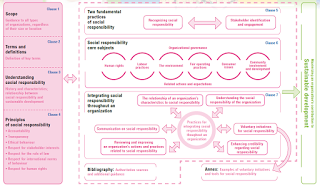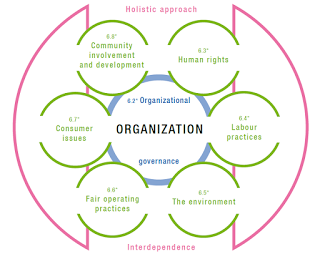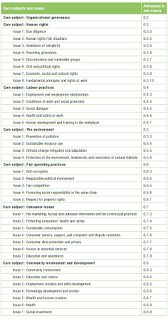In Part 1, we have learned what ISO 26000:2010 is about. In this post we are going to go deeper and understand a little bit more about its implementation.
How to use the standard? – Schematic overview –
(Click on the image to enlarge)
This image is intended to assist organizations in understanding how to use the standard. Here are some points ISO highlights as useful to follow when applying the standard:
- After considering the characteristics of SR and its relationship with sustainable development (Clause 3), it is suggested that an organization should review the principles of SR described in Clause 4. In practicing SR, organizations should respect and address these principles, along with the principles specific to each core subject (Clause 6).
- Before analyzing the core subjects and issues of SR, as well as each of the related actions and expectations (Clause 6), an organization should consider two fundamental practices of SR: recognizing its social responsibility within its sphere of influence, and identifying and engaging with its stakeholders (Clause 5).
- Once the principles have been understood, and the core subjects and relevant and significant issues of SR have been identified, an organization should seek to integrate SR throughout its decisions and activities, using the guidance provided in Clause 7. This involves practices such as: making SR integral to its policies, organizational culture, strategies and operations; building internal competency for SR; undertaking internal and external communication on SR; and regularly reviewing these actions and practices related to SR.
Clause 4: 7 Principles
- Accountability: An organization should be answerable to those affected by its decisions and activities, as well as to society in general, for the overall impact on society and its decisions and activities.
- Transparency: An organization should disclose, in a clear, accurate manner and to a reasonable and sufficient degree, the policies, decisions, and activities for which it is responsible, including known and likely impacts on society and the environment. .
- Ethical behavior: An organization’s behavior should be based on the ethics of honesty, equity, and integrity.
- Respect for Stakeholder Interests: Although an organization’s objectives may be limited to the interests of its respective owners, members, customers or constituents, other individuals or groups may also have rights, claims or specific interests that should be taken into account. Collectively, these individuals or groups comprise the organization’s stakeholders.
- Respect for the Rule of Law: An organization should comply with all applicable laws and regulations. The rule of law refers to the supremacy of law and, in particular, to the idea that no individual or organization stands above the law and that government is also subject to the law.
- Respect for International Norms of Behavior: An organization should respect international norms of behavior while adhering to the principle of respect for the rule of law.
- Respect for Human Rights: An organization should respect human rights and recognize both their importance and their universality. In situations where human rights are not protected, take steps to respect human rights and avoid taking advantage of these situations.
Clause 6: 7 Core subjects and issues of SR
(Click on the images to enlarge)
REFERENCES
– All the information in this post was extracted from from ISO.org Link1 and Link2.








